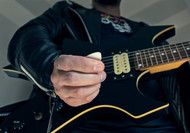How to Play Guitar Like Slipknot
Mar 14th 2024
How to Play Guitar Like Slipknot

Since exploding onto the scene with their debut studio album in 1999, Slipknot has become one of the world’s most famous heavy metal acts. Their intense energy, bombastic style and aggressive music have led to album sales of more than 30 million and a legion of fans that sell out shows around the globe.
Behind that flash, though, is some impressive guitar playing. It takes a lot of technical skill to create the controlled chaos that Slipknot is known for. Mick Thomson and Jim Root, who each have been with the band for more than 25 years, have been the driving force behind songs like “Left Behind”, “Duality”, “Snuff” and “The Devil in I”.
Are you looking to learn some Slipknot songs? The team at Strings and Beyond is here. Today, we’re here to discuss some of the techniques commonly used to play Slipknot on guitar along with offering advice on strings and picks.
Slipknot Guitar Tuning and Strings
Before anything else, you’ll need to get your guitar in the proper tuning to play Slipknot. Most of their songs played on a standard guitar are in Drop-B tuning. This goes B2-F#2-B3-E3-G#3-C#4, with the sixth string tuned down five half-steps from standard tuning and the other five strings down three half-steps. Some of their songs use even lower tunings like Drop-A!
These tunings are what give Slipknot songs their unique low growl. It also makes them easier to play since you just need your index finger for many power chords. However, since this means significantly less string tension, you will need much heavier strings; lighter-gauge strings are likely to just flop around and quickly fall out of tune. Slipknot guitarist Mick Thomson reportedly uses customized D’Addario EXL117 guitar strings and D’Addario XT strings — 11s for Drop-B tuning and 12s for Drop-A tuning.

Guitar Picks
You’ll also need a good pick to play Slipknot correctly. Since the strings will be more flexible in extreme down-tuning, playing them normally with a medium or hard pick will cause the notes to be sharp and have too much gain. The easiest solution is to use a softer pick, but this may produce more string noise than you want. With a heavier pick, you’ll need to play lighter — and the pick will need plenty of grip so you don’t drop it during those crazy riffs. One of the picks Mick Thompson uses is the Dunlop Carbon Fiber Max Grip Jazz III.
Tremolo Picking
Slipknot songs tend to have fast tempos with a lot of sixteenth notes. As such, tremolo picking will be important. This is when you alternate picking upwards and downwards on the same string or strings. By using tremolo picking, you can hit strings with much quicker frequency and even create a pulsating effect when needed. Be careful not to rush, though. If you rush, the music won’t sound as heavy — and then it isn’t heavy metal anymore. It’s better to lag a bit behind the beat than speed ahead.

Palm Muting and Fret Muting
One of the key features of Slipknot songs and heavy metal is that the notes are pronounced and well-defined. You’re not looking for long, majestic sustain like on a power ballad. Palm muting and fret muting are ways to shorten notes so they’re more rhythmic and fit with the drum beats.
Each muting technique produces different effects. Palm muting is when you place the heel or side of your picking hand across the strings just in front of the bridge. This will make the notes chunkier and crunchier while greatly lowering the sustain. Increasing string pressure or moving the hand further from the bridge will mute them more, although too much muting can cause strings to be too muffled and/or out of tune.
Fret muting is when you use your fret hand to mute the strings along the next. This has a couple of uses. You can play a chord or single string at full strings, then use your fret hand to dampen the string(s) and cut the note off. You can also hold your fret hand across the strings to create “percussion clicks” between notes. Heavy metal guitarists will even add harmonics via fret muting — and if you brush the string with your thumb during a harmonic, it lifts the pitch for a cool squealing effect. Both muting methods are important to master if you’re playing Slipknot, Pantera, Megadeth or any other heavy metal music.

Hammer-on and Pull-off
One question you’ll need to ask is, “Which Slipknot guitarist do I want to sound like?” While Mick Thomson picks almost every note, Jim Root is known for employing the hammer-on and pull-off techniques to complement him. Hammer-on is when you slam a fret-hand finger onto the fingerboard hard enough to sound the note(s) that correspond to the fret you’re behind. Pull-off is when you play a note or chord, then pull your fingers off the fretboard as the strings are still vibrating. The skills can be used separately or together.
Being able to hammer on and pull off is a must for many heavy metal songs. With the drop tuning, you can use these techniques to quickly alternate between power chords with a smoother transition. They allow for faster playing in general since you don’t need to pick as fast and less coordination is needed between your picking and fretting hands. The sound of notes from hammer-on and pull-off won’t be as bright or sustain — but you’ve probably gathered by now that these things don’t matter much for Slipknot songs.
Best Slipknot Songs for Beginners
Are you ready to give it a whirl? Here are some easy Slipknot songs on guitar to get you started:
1.“Snuff”
2.“Eyeless”
3.“The Devil in I”
4.“Dead Memories”
5.“Pyschosocial”
6.“Unsainted”
7.“Duality”
8.“Before I Forget”
9.“Spit it Out”
10.“Purity”

